Was going over some old minue lessons today and found this interesting quote.
"When I was a kyu, I studied this basic joseki variations over and over again (maybe 10~15 times). Other joseki? I just ignored. This applies to other Go study topic. Talking about L&D, it's good to solve new problems. Much better than doing nothing. But, it's even better to solve again several times which we solved in past. So, in summary, for efficiency of Go study, we have to simplfy our study span, and focus on them. I dont mean, u should stop reviews with ur Go friends and many other enjoyable Go studies. What i mean is.. we have to give a priority to some specifid Go study plan, and focus on them. About all other Go study, we just regard as "fun"
So, when we can finish some specific topic? --> when we can find Correct responses on all expected opp's moves without any difficulty, but instantly. All these variations.. So, quantity is not so important. Quality (or intensity) matters more. For example, to study about this just one basic hoshi joseki is much better than to study 100 basic hoshi josekis superficially (for improving)"
I have been doing that over the last few months, and I think it is helping. It took me a while to figure out which study plan works for me, and to get rid of the nasty blitz habit (which was taking away from study time). I used to think that I had to know 'all those joseki' and was feeling kind of overwhelmed. Now I just choose one basic joseki / variation which I study more deeply for a while, and don't worry about the other 29,999 I am not studying right then.
The interesting thing is that the shapes I am studying, suddenly start coming up in other situations too, and my study proves to be useful outside this one joseki variation.
A friend just studied l-groups very deeply and it has definitely helped his game too. They are on my long list of 'subjects to study soon'.
Just finished the first semeai book of the Korean Problem Academy books. All pretty easy, but good reading practice. Today, I'll start on the second one. That is, after I finish my joseki study ^^.
Tuesday, December 26, 2006
Wednesday, December 20, 2006
Studying
Vincent asked to share more about my studying, so here goes.
I would like to say that I am a very organized person, and have a wonderful study plan, but I have to admit I am not. Just like in playing, focus and discipline are the main issues in my studying. I will study for a bit, check some email, study a few minutes, surf some links, study a bit, make some tea, remember that I was studying, and so on. I often end up not studying as much as I wanted.
As a very concrete example, just played through some recently studied pro games and now am writing this blog entry. Could have played through more games instead. It is something I'll need to work on, have to find what works for me.
But even with all the distractions (including the seven handicap stones I have running around ^^), I still get quite a lot of studying in most days. I always start with replaying some pro games, usually a few recently memorized ones, and I will take one older one and look at it again. Yesterday, I looked at the Yuzo - Shusaku game. I often see new things in old games when I look at them again a few weeks / months after studying.
I do go problems every day, a lot of easier ones, and usually some harder ones (but don't always get to the harder ones). My goal used to be 50 a day, but I don't really keep track anymore. I think I do at least 20 on a typical day, and often still reach 50 or more. It depends on how much car I spend in the car, waiting for my kids. Those problems are easy ones though, working through volume 1 of the semeai book of the Korean Problem Academy now, and whatever else I have laying around.
I have wondered whether it would be better to do a lot of easy problems, or a few harder problems when studying. I have read conflicting opinions on this. Last week, I asked sendol about this, and he said both are good.
I go through game reviews and recent lessons, to see again where I went wrong and where I consistently missed a big move. (still ^^) I also am slowly working my way through the lectures on the audiogolessons web site, it's a wonderful resource.
I have no idea how much time I would spend on an average day, since my study time is interrupted often by real life. But I hope this gives some idea of the things I study. I enjoy all of those, replaying pro games has a meditative aspect to it. And there is a thrill when I finally find the correct answer to a more difficult problem.
I would like to say that I am a very organized person, and have a wonderful study plan, but I have to admit I am not. Just like in playing, focus and discipline are the main issues in my studying. I will study for a bit, check some email, study a few minutes, surf some links, study a bit, make some tea, remember that I was studying, and so on. I often end up not studying as much as I wanted.
As a very concrete example, just played through some recently studied pro games and now am writing this blog entry. Could have played through more games instead. It is something I'll need to work on, have to find what works for me.
But even with all the distractions (including the seven handicap stones I have running around ^^), I still get quite a lot of studying in most days. I always start with replaying some pro games, usually a few recently memorized ones, and I will take one older one and look at it again. Yesterday, I looked at the Yuzo - Shusaku game. I often see new things in old games when I look at them again a few weeks / months after studying.
I do go problems every day, a lot of easier ones, and usually some harder ones (but don't always get to the harder ones). My goal used to be 50 a day, but I don't really keep track anymore. I think I do at least 20 on a typical day, and often still reach 50 or more. It depends on how much car I spend in the car, waiting for my kids. Those problems are easy ones though, working through volume 1 of the semeai book of the Korean Problem Academy now, and whatever else I have laying around.
I have wondered whether it would be better to do a lot of easy problems, or a few harder problems when studying. I have read conflicting opinions on this. Last week, I asked sendol about this, and he said both are good.
I go through game reviews and recent lessons, to see again where I went wrong and where I consistently missed a big move. (still ^^) I also am slowly working my way through the lectures on the audiogolessons web site, it's a wonderful resource.
I have no idea how much time I would spend on an average day, since my study time is interrupted often by real life. But I hope this gives some idea of the things I study. I enjoy all of those, replaying pro games has a meditative aspect to it. And there is a thrill when I finally find the correct answer to a more difficult problem.
Tuesday, December 19, 2006
Yuzo - Shusaku
Today, I spent some time studying game eight from the Yuzo - Shusaku sanjubango, played on March 7th, 1853. I finally got the book Invincible, and realized this game must be in it. I have studied it before, and it was interesting to get new insights from reading the commentary in Invincible. It also gave me some more historical background on this sanbujango (30 games match)

From Invincible "Shusaku's greatest achievement was his flawless record in the castle games, but the real climax of his career was the sanjubango with Ota Yuzo in 1853. Aged 23, Shusaku was approaching his peak; he had already scored eight of those wins in the castle games and had also bested all the top players of the day in individual encounters. The only player to hold his own against Shusaku was Ota Yuzo, 22 years his senior."
"The sanjubango between Yuzo and Shusaku is the most famous bango of the classical period and it represents a fitting climax to Edo period go."
Game eight of this series always has been one of my favorite games, it is fascinating to see how Black relentlessly attacks White. This three-way splitting attack is bloody awesome:
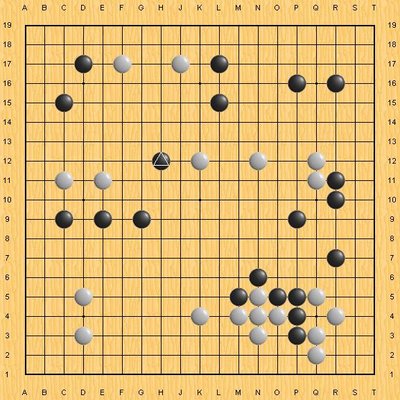
This is a great game to study and enjoy. It is the shortest of the series, but one of the most spectacular ones.

From Invincible "Shusaku's greatest achievement was his flawless record in the castle games, but the real climax of his career was the sanjubango with Ota Yuzo in 1853. Aged 23, Shusaku was approaching his peak; he had already scored eight of those wins in the castle games and had also bested all the top players of the day in individual encounters. The only player to hold his own against Shusaku was Ota Yuzo, 22 years his senior."
"The sanjubango between Yuzo and Shusaku is the most famous bango of the classical period and it represents a fitting climax to Edo period go."
Game eight of this series always has been one of my favorite games, it is fascinating to see how Black relentlessly attacks White. This three-way splitting attack is bloody awesome:

This is a great game to study and enjoy. It is the shortest of the series, but one of the most spectacular ones.
Sunday, December 17, 2006
Playing Less
And studying more. I have been annoyed by my lack of reading ability, so dived into volume one of the Korean Problem Academy semeai book. Easy problems, but I hope doing lots of them will help me increase my reading power.
Also been doing more basic reading problems and l/d problems, and focusing more on pro games. I haven't played blitz in ages, which frees up time for other things. I have been playing less, but the games I played were more serious. Which can only be a good thing, right?
Also been doing more basic reading problems and l/d problems, and focusing more on pro games. I haven't played blitz in ages, which frees up time for other things. I have been playing less, but the games I played were more serious. Which can only be a good thing, right?
Sunday, December 10, 2006
Tournament Tales III: The Games
My first game was againt a 1k. We both made mistakes, but I was leading till late yose when I missed some aji and lost too many points. End result 'W + 1.5' (This was a no komi game). I blame the stupid talking clocks, I have a hard time focusing once they start yelling at me. But it was a good game to study, so I didn't care.
The second game was against a shodan. I got 2H and did ok, he ended up resigning.
Last game was against a 2d. This was a 3H game. My opening was ok, but I totally screwed up the middle game fighting. Very very badly. I resigned.
I feel I played three good games, with mistakes, but also with some good moves. My time management is getting better, but the byo yomi still gets to me. I have considered playing faster, but I realized it was more important to fix my go first, and work on time management later. Time issues seem easier to fix. Tournament experience will help with it.
I enjoyed all the games and actually felt very calm while playing, so I guess some of my preparation did pay off. I also felt that watching the 'Winning a Won Game' lecture was very helpful, even if I ended up losing my won game :) I played reasonable games, with lots of study material in them. What really helped me mentally, was playing through pro games just before the tourney. It was very calming.
I kept my focus well during the games, so that was good. I now realize that my mental preparation was way more important than my go preparation. I wasn't going to increase much of my go skills in just a few days, but finding calmness and focus was a big help for accessing my existing go skills.
After the game, four of us went out for a nice dinner to rehash the day's games and happenings. Great day, filled with go and fun. Long drive back home, but it was worth it. I left the house at 7am , and came back after 11pm. Would do it again in a heartbeat. Just wish we had more tournaments in New England.
The second game was against a shodan. I got 2H and did ok, he ended up resigning.
Last game was against a 2d. This was a 3H game. My opening was ok, but I totally screwed up the middle game fighting. Very very badly. I resigned.
I feel I played three good games, with mistakes, but also with some good moves. My time management is getting better, but the byo yomi still gets to me. I have considered playing faster, but I realized it was more important to fix my go first, and work on time management later. Time issues seem easier to fix. Tournament experience will help with it.
I enjoyed all the games and actually felt very calm while playing, so I guess some of my preparation did pay off. I also felt that watching the 'Winning a Won Game' lecture was very helpful, even if I ended up losing my won game :) I played reasonable games, with lots of study material in them. What really helped me mentally, was playing through pro games just before the tourney. It was very calming.
I kept my focus well during the games, so that was good. I now realize that my mental preparation was way more important than my go preparation. I wasn't going to increase much of my go skills in just a few days, but finding calmness and focus was a big help for accessing my existing go skills.
After the game, four of us went out for a nice dinner to rehash the day's games and happenings. Great day, filled with go and fun. Long drive back home, but it was worth it. I left the house at 7am , and came back after 11pm. Would do it again in a heartbeat. Just wish we had more tournaments in New England.
Tournament Tales II: Early Morning
When you live in the middle of nowhere, you can not just take the bus or metro to a go tournament. No, you need to drive through snow covered mountains for hours, and hours. Which also means you have to get up at some ungodly hour to arrive there in time.
We had it all set up perfectly. I left my house at 7am, to pick up a friend and we would meet two other friends at 8:45am in Vermont to car pool from there. I arrived at my friend's house and waited for him, but nothing happened. I rang the bell, knocked the door, nothing happened. Time was passing.
Decided to check his fraternity to see whether he was there, but no luck. Back to his house, where I finally managed to wake up his room mate who woke up my friend. Time was passing.
By now it was so much past the original time to meet, that we knew we would have to drive to the tournament ourselves. So we bought a map of Vermont, and desperately called around to people, finding out that Vermont doesn't have much cell phone reception. Eventually managed to reach the Tournament Director, to tell him that we were late, but would be there in time for the second round.
We relaxed and talked about go, and arrived there while the first round was still going on, all was good.
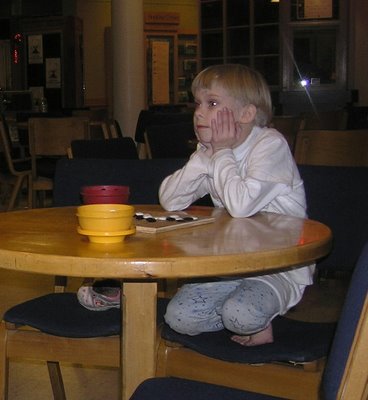
I found that I still was stressed though, so decided to play through some memorized games to calm myself. I started with the ear reddening game, and managed to screw up the taisha like four times before I got it right. Not a good sign. I guess I wasn't as calm as I had envisioned myself.
Moved on to Go Seigen's Game of the Century, and it didn't take long before my friend joined me and he played W, I played B. We were fuzzy on a few details, but managed most of it. After playing through most of it once, went through it again, this time straightening out the details we missed before. I found that playing out a pro game on a board really helped to ground me and get me ready for my games.
Almost time for the second round, the pairings were being decided. I had entered as a 2k, and my first game was against a 1k. Good time to measure whether the 2k rank was a reasonable guess.
We had it all set up perfectly. I left my house at 7am, to pick up a friend and we would meet two other friends at 8:45am in Vermont to car pool from there. I arrived at my friend's house and waited for him, but nothing happened. I rang the bell, knocked the door, nothing happened. Time was passing.
Decided to check his fraternity to see whether he was there, but no luck. Back to his house, where I finally managed to wake up his room mate who woke up my friend. Time was passing.
By now it was so much past the original time to meet, that we knew we would have to drive to the tournament ourselves. So we bought a map of Vermont, and desperately called around to people, finding out that Vermont doesn't have much cell phone reception. Eventually managed to reach the Tournament Director, to tell him that we were late, but would be there in time for the second round.
We relaxed and talked about go, and arrived there while the first round was still going on, all was good.

I found that I still was stressed though, so decided to play through some memorized games to calm myself. I started with the ear reddening game, and managed to screw up the taisha like four times before I got it right. Not a good sign. I guess I wasn't as calm as I had envisioned myself.
Moved on to Go Seigen's Game of the Century, and it didn't take long before my friend joined me and he played W, I played B. We were fuzzy on a few details, but managed most of it. After playing through most of it once, went through it again, this time straightening out the details we missed before. I found that playing out a pro game on a board really helped to ground me and get me ready for my games.
Almost time for the second round, the pairings were being decided. I had entered as a 2k, and my first game was against a 1k. Good time to measure whether the 2k rank was a reasonable guess.
Tournament Tales I: The Preparation
So much to tell about the tourney. It was a wonderful day. I will have to do it in installments, as to also get some studying in. Especially for Ash, I'll start with how I prepared for this tourney.
First step was my familiar pre-tourney 'I will lose all my games!' stress-out. I talked about this with a friend and he helpfully told me that he still HATES playing tournament games (after soooo many years of playing them). He did tell me that it would help to play in a lot of tournaments, so that will be one of the steps of my recovery program :) I wallowed in my negative state of self-pity, till Flameblade slapped me out of it and told me to get over it already (paraphrased). He gave me helpful tips, and I replaced my whining with visions of Calmness, Focus, and Good Moves. Not to say that the fear of losing all my games was totally gone, but it was just a tiny bit of self doubt instead of an almost all-consuming worry.
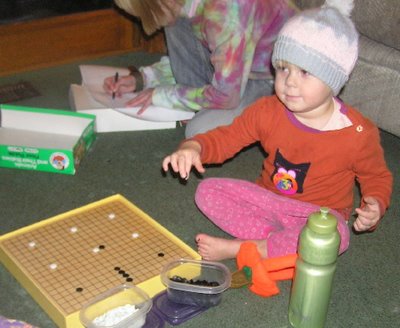
I wanted to do extra tsumego before the tourney, but ended up doing my normal amount. I avoided 'non-thinking' games on mess-up accounts, only played serious games for the days leading up to the tourney. I spent a lot of time replaying pro games, feeling that the spirit of those games would help me in my tournament.
I did some joseki review, but not much. I figured that if a particular joseki wasn't in my head by now, would be hard to study it in a hurry just to not use it in the tournament anyway.
At go club, we played a serious simul instead of normal relaxed club games, which also helped me to get into the tournament mood. The night before the tourney, I watched one of Guo Juan's 'How to Win a Won Game' lectures, and attended the shygost lecture. I even went to bed before midnight!
Stay tuned for Episode II.
First step was my familiar pre-tourney 'I will lose all my games!' stress-out. I talked about this with a friend and he helpfully told me that he still HATES playing tournament games (after soooo many years of playing them). He did tell me that it would help to play in a lot of tournaments, so that will be one of the steps of my recovery program :) I wallowed in my negative state of self-pity, till Flameblade slapped me out of it and told me to get over it already (paraphrased). He gave me helpful tips, and I replaced my whining with visions of Calmness, Focus, and Good Moves. Not to say that the fear of losing all my games was totally gone, but it was just a tiny bit of self doubt instead of an almost all-consuming worry.

I wanted to do extra tsumego before the tourney, but ended up doing my normal amount. I avoided 'non-thinking' games on mess-up accounts, only played serious games for the days leading up to the tourney. I spent a lot of time replaying pro games, feeling that the spirit of those games would help me in my tournament.
I did some joseki review, but not much. I figured that if a particular joseki wasn't in my head by now, would be hard to study it in a hurry just to not use it in the tournament anyway.
At go club, we played a serious simul instead of normal relaxed club games, which also helped me to get into the tournament mood. The night before the tourney, I watched one of Guo Juan's 'How to Win a Won Game' lectures, and attended the shygost lecture. I even went to bed before midnight!
Stay tuned for Episode II.
Friday, December 08, 2006
Tourney Training
I am in my normal pre-tourney 'I can't play go, I will lose all my games, and this will prove how worthless I am!' phase. Gotta love that pre-tourney stress I can talk myself into.

Last night, I whined about it to a good KGS friend, and told her I wasn't too worried about playing stronger players, but I was wondering about my handicap giving skills. She said 'Why don't you try giving me handi?', so we played at 8H. I wasn't too impressed with my handi skills but managed to kill a big group. Still a close game though. At least it made me feel better about giving handi.
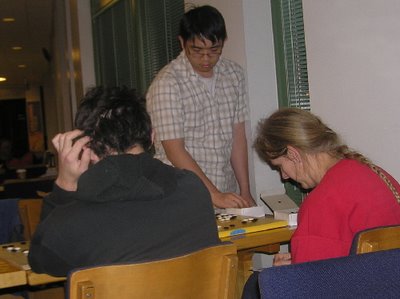
Today at go club, we worked on tourney training also. Our 4d gave a simul, playing five people (well, one was Kate on 9x9 :). I took 4H and had a reasonable game. I got all four corners and reduced enough of his huge center to win. Still made too many mistakes though. Will have to work on that :)
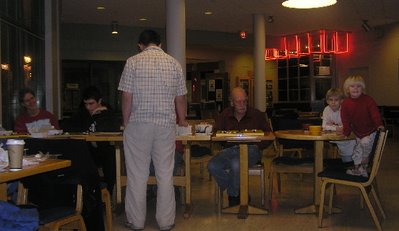
Drove home in our first snow storm, it'd better not snow on Saturday! The tourney is at the other side of Vermont, will have to cross the Green Mountains.

Before the simul, Kate played her 2 years-old sister Sylvia. Sylvia loves playing with Kate, even has learned how to hold the stones correctly. And Kate enjoys teaching Sylvia. It will be a while before she gets the game, but they are having fun together.

They played seriously for a while, but then it evolved into this ^^

Last night, I whined about it to a good KGS friend, and told her I wasn't too worried about playing stronger players, but I was wondering about my handicap giving skills. She said 'Why don't you try giving me handi?', so we played at 8H. I wasn't too impressed with my handi skills but managed to kill a big group. Still a close game though. At least it made me feel better about giving handi.

Today at go club, we worked on tourney training also. Our 4d gave a simul, playing five people (well, one was Kate on 9x9 :). I took 4H and had a reasonable game. I got all four corners and reduced enough of his huge center to win. Still made too many mistakes though. Will have to work on that :)

Drove home in our first snow storm, it'd better not snow on Saturday! The tourney is at the other side of Vermont, will have to cross the Green Mountains.

Before the simul, Kate played her 2 years-old sister Sylvia. Sylvia loves playing with Kate, even has learned how to hold the stones correctly. And Kate enjoys teaching Sylvia. It will be a while before she gets the game, but they are having fun together.

They played seriously for a while, but then it evolved into this ^^
Monday, December 04, 2006
The Most Complicated Joseki of All
Talking about the large avalanche. Usually when people start the avalanche, I take the easy way out, but last week I decided differently. Figured the only way to learn to play it is by actually experimenting with it and get killed many times over :)
I played this game at club in which W started an avalanche pattern:
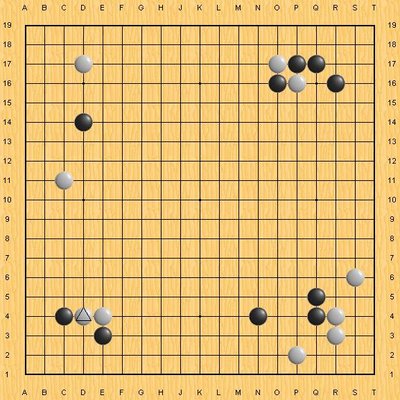
Usually I take the easiest way out and play like this:

Seems too good for W on this board though. According to sendol, the correct way to play would have been this way:

This looks a lot better for B. I hadn't seen that solution though, so decided to take a deep breath and start the large avalanche. Worst thing I could do was screw it up, right?
It wasn't too bad, just didn't punish when W played wrong order of moves. At least thanks to sendol, I now know the proper punishment :) Of course, 'not too bad' was talking about locally, globally the result feels good for W.
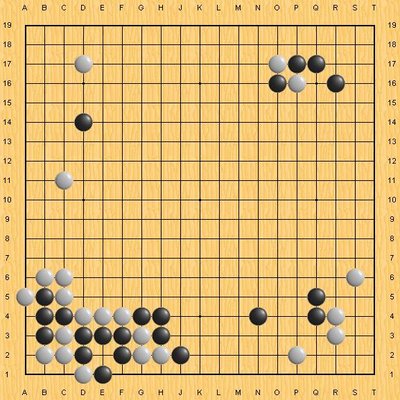
But at this point, I didn't care, was just happy to actually have played the large avalanche in a game and not mess it up too badly. The rest of the game was very interesting, but I missed fatal chances and ended up getting myself killed. Oh well, I enjoyed it anyway. And I learned quite a lot, will have to spend more time studying this. So much to study, so little time ^^
I played this game at club in which W started an avalanche pattern:

Usually I take the easiest way out and play like this:

Seems too good for W on this board though. According to sendol, the correct way to play would have been this way:

This looks a lot better for B. I hadn't seen that solution though, so decided to take a deep breath and start the large avalanche. Worst thing I could do was screw it up, right?
It wasn't too bad, just didn't punish when W played wrong order of moves. At least thanks to sendol, I now know the proper punishment :) Of course, 'not too bad' was talking about locally, globally the result feels good for W.

But at this point, I didn't care, was just happy to actually have played the large avalanche in a game and not mess it up too badly. The rest of the game was very interesting, but I missed fatal chances and ended up getting myself killed. Oh well, I enjoyed it anyway. And I learned quite a lot, will have to spend more time studying this. So much to study, so little time ^^
Saturday, December 02, 2006
Yilun Yang's Workshop Lectures, Volume 2
My leg has been acting up, so I figured that would be a good opportunity to lay down and read volume 2 of Yang's Workshop Lectures. I had been looking forward to reading this volume, and yet again, I did not get disappointed. I always wanted to attend one of the Yang workshops, but couldn't pull it off logistically, and this seems like it's the next best thing.
The first lecture is on How to Invade. It gives rules of when invading is possible, and shows how to decide where to invade and how to follow up. In the process of invading, it also gives a lot of information on life and death. Yang has a multi step process on how to live and how to kill. I had heard about his killing process, but it was nice to see the rules on paper and explained more. It made more sense with the examples he gave as opposed to when I just heard the steps listed.
Lecture nr 2 was about Choosing the Right Pincer. This is similar to one of the chapters in his 'Fundamental Principles of Go'. This lecture seemed to go deeper (I don't have the fundamental book with me to compare, this is just from memory). He also talks about how to think and find the right move when your opponent plays a non-standard reply to the pincer. Interesting stuff and it explained why I got a bad result in a few recent games. It is nice to see so many things which are immediately applicable in one's games.
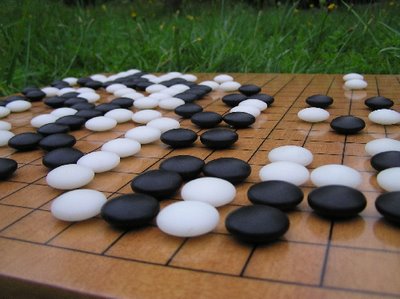
The third lecture is about side extensions in the opening. This lecture gave me a lot of new information. New tidbits to ponder about the opening. Over time, I have spent so many hours staring at board positions, trying to figure out what would be the best extension in that situation. This book will help me make better choices. This chapter, like all the others, is full of practical examples.
Fourth lecture is 'Playing a Territorial Game'. I know I am raving, but I am just amazed at the amount of information packed in a relatively small book. I have played territorial games where my opponent ended up with the whole center and I wasn't able to destroy it. This book gives me new tools and new ways to play territorial games, I can't wait to experiment with it.
Last lecture is the opposite subject with 'Playing a Moyo Game'. It gives a lot of guidelines for moyo games, how to play, how not to play. It shows a generous number of examples of how to deal with invasions in your moyo, and about correct and wrong direction of play. In both of these chapters, he stresses how important it is to be consistent, and not to switch back and forth between different styles of play. A good lesson to learn.
This book has so much information, it will take me a while to study and digest it all. I feel I only touched the tip of the knowledge in here during my first reading. It warrants sitting down with a goban and playing out the different variations. Over and over. I will take the book to go club with me today, will be good to complement our study session.
The first lecture is on How to Invade. It gives rules of when invading is possible, and shows how to decide where to invade and how to follow up. In the process of invading, it also gives a lot of information on life and death. Yang has a multi step process on how to live and how to kill. I had heard about his killing process, but it was nice to see the rules on paper and explained more. It made more sense with the examples he gave as opposed to when I just heard the steps listed.
Lecture nr 2 was about Choosing the Right Pincer. This is similar to one of the chapters in his 'Fundamental Principles of Go'. This lecture seemed to go deeper (I don't have the fundamental book with me to compare, this is just from memory). He also talks about how to think and find the right move when your opponent plays a non-standard reply to the pincer. Interesting stuff and it explained why I got a bad result in a few recent games. It is nice to see so many things which are immediately applicable in one's games.

The third lecture is about side extensions in the opening. This lecture gave me a lot of new information. New tidbits to ponder about the opening. Over time, I have spent so many hours staring at board positions, trying to figure out what would be the best extension in that situation. This book will help me make better choices. This chapter, like all the others, is full of practical examples.
Fourth lecture is 'Playing a Territorial Game'. I know I am raving, but I am just amazed at the amount of information packed in a relatively small book. I have played territorial games where my opponent ended up with the whole center and I wasn't able to destroy it. This book gives me new tools and new ways to play territorial games, I can't wait to experiment with it.
Last lecture is the opposite subject with 'Playing a Moyo Game'. It gives a lot of guidelines for moyo games, how to play, how not to play. It shows a generous number of examples of how to deal with invasions in your moyo, and about correct and wrong direction of play. In both of these chapters, he stresses how important it is to be consistent, and not to switch back and forth between different styles of play. A good lesson to learn.
This book has so much information, it will take me a while to study and digest it all. I feel I only touched the tip of the knowledge in here during my first reading. It warrants sitting down with a goban and playing out the different variations. Over and over. I will take the book to go club with me today, will be good to complement our study session.
Friday, December 01, 2006
One Month of Go
Kate has played for about a month now and seems to be getting more addicted. I can only approve. Yesterday was the first time she could come to go club again after I broke my leg. She was very happy about it. 'It feels so good, it feels like going to a friend's house!' Glad she likes the atmosphere at club.

She has been playing some games on KGS. Today, I looked through them and she is up to 39 of them now. Most of those were 9x9 though, she is still hesitant to play 19x19. She does play 19x19 on her own goban but it seems scary to her on KGS. I told her she could try playing a 37x37 game and then 19x19 would seem small, but she didn't fall for it.
She is improving fast, I love watching her figuring out things and starting to read more. She still leaves cuts, but more and more she is looking at them and actually reading out before protecting. Showing me 'See, if he plays here, I can play here, and he will play there, and I will play here, and he will be dead'. Fascinating process.

She has been playing some games on KGS. Today, I looked through them and she is up to 39 of them now. Most of those were 9x9 though, she is still hesitant to play 19x19. She does play 19x19 on her own goban but it seems scary to her on KGS. I told her she could try playing a 37x37 game and then 19x19 would seem small, but she didn't fall for it.
She is improving fast, I love watching her figuring out things and starting to read more. She still leaves cuts, but more and more she is looking at them and actually reading out before protecting. Showing me 'See, if he plays here, I can play here, and he will play there, and I will play here, and he will be dead'. Fascinating process.
Wednesday, November 29, 2006
Interesting
You know when you are staring at a problem, reading and reading and not finding the right answer? Lately, I just stop reading and skip it, coming back to it the next day. And surprisingly enough, the answer will suddenly be there and totally obvious. Amazing how the human mind works.
After a short stint of getting too addicted, I again have totally given up on blitz games now. (Last time a friend was my downfall, but not going to happen again) I do not play unless I know I can actually think and have some time. If not, I do problems or any other studying. Or hang out on KGS and be social ^^.
Both sendol and minue told me blitz was not good for me, I am trusting their judgement, even if the blitz period was fun while it lasted. Some day I'll play a lot of blitz again, but first need to get myself strong.
There is a Dec 9th tournament coming up in Vermont, will have to decide at what level to enter. Ranks are such a pain, I'd rather just play and not think about rank at all.
After a short stint of getting too addicted, I again have totally given up on blitz games now. (Last time a friend was my downfall, but not going to happen again) I do not play unless I know I can actually think and have some time. If not, I do problems or any other studying. Or hang out on KGS and be social ^^.
Both sendol and minue told me blitz was not good for me, I am trusting their judgement, even if the blitz period was fun while it lasted. Some day I'll play a lot of blitz again, but first need to get myself strong.
There is a Dec 9th tournament coming up in Vermont, will have to decide at what level to enter. Ranks are such a pain, I'd rather just play and not think about rank at all.
Monday, November 27, 2006
Yilun Yang's Workshop Lectures
Just read the new Yilun Yang book, his Workshop Lectures, Volume 1. I had read his Fundamental Principles of Go before, and was very impressed with that one. So I was looking forward to seeing his workshop lectures.
Last night, I took this book up with me as bedtime reading. It didn't take me long to get totally caught in the book, but sadly I fell asleep. First thing this morning, before even taking a shower or eating breakfast, I picked up the book again and read the rest of it. Best word to describe it: 'Wow!'
It is divided in three chapters. The first one talks about 'When to tenuki in the opening'. It gives excellent general guidelines for when you can tenuki and when you cannot. It did clear up a bunch of things for me, some of which I kind of knew but never saw verbalized so well, some which gave new and exciting insights. I will have to read it a few more times to really internalize all the information he is giving in a very concise manner.
The second one is about 'Choosing the direction of attack'. Again, very eye-opening, very enlightening, very clear. I think this is the chapter I am most excited about. I do like attacking, but I don't always think clearly about best direction or best way. This will help me better to figure out direction of play during attacking. He gives a lot of examples, will have to sit down with my goban and play them out to get a better feel for this all.
The third and final chapter talks about 'Playing complicated joseki'. He states that memorizing sequences is not important, what is important is to know the rules for contact fighting and how to apply them in messy situations. In that case, if your opponent plays a non-joseki move, you won't be lost, but you will have tools to deal with it. He uses the taisha as an example. He shows a typical sequence and what to do when opponent diverges from it. How to think to find the best play. This is another chapter I will have to study more closely.
I can only give this book a big thumbs-up, it is excellently written and full of valuable information. I also bought his Workshop Lectures, Volume 2, and very much looking forward to reading that one. But I'd better first have breakfast and a shower ^^
Last night, I took this book up with me as bedtime reading. It didn't take me long to get totally caught in the book, but sadly I fell asleep. First thing this morning, before even taking a shower or eating breakfast, I picked up the book again and read the rest of it. Best word to describe it: 'Wow!'
It is divided in three chapters. The first one talks about 'When to tenuki in the opening'. It gives excellent general guidelines for when you can tenuki and when you cannot. It did clear up a bunch of things for me, some of which I kind of knew but never saw verbalized so well, some which gave new and exciting insights. I will have to read it a few more times to really internalize all the information he is giving in a very concise manner.
The second one is about 'Choosing the direction of attack'. Again, very eye-opening, very enlightening, very clear. I think this is the chapter I am most excited about. I do like attacking, but I don't always think clearly about best direction or best way. This will help me better to figure out direction of play during attacking. He gives a lot of examples, will have to sit down with my goban and play them out to get a better feel for this all.
The third and final chapter talks about 'Playing complicated joseki'. He states that memorizing sequences is not important, what is important is to know the rules for contact fighting and how to apply them in messy situations. In that case, if your opponent plays a non-joseki move, you won't be lost, but you will have tools to deal with it. He uses the taisha as an example. He shows a typical sequence and what to do when opponent diverges from it. How to think to find the best play. This is another chapter I will have to study more closely.
I can only give this book a big thumbs-up, it is excellently written and full of valuable information. I also bought his Workshop Lectures, Volume 2, and very much looking forward to reading that one. But I'd better first have breakfast and a shower ^^
Using Thickness
Episode 42 in the saga 'Things I should know, but still mess up'. It's amazing how hard it can be to actually use the knowledge I have in the right way. Today's episode is about thickness, how to use it , how not to use it. My last teaching game against minue was a perfect example of how not to use it.
This was the position:
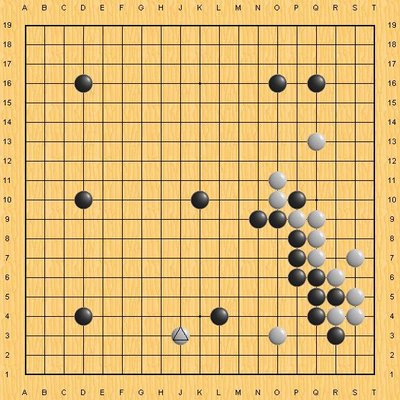
W just played the marked stone. Pretty clearcut, B has lots of thickness and needs to use it. My kyu mind immediately came to the conclusion that I should use this thickness for fighting, and I'd better split the two W stones and get them into trouble. I sometimes get carried away by my natural aggression.

I totally and utterly missed the bigger picture of driving W towards my wall. The obvious direction of play. The only direction of play.

minue622 [7d?]: so here,
minue622 [7d?]: A is better, (to drive white toward wall)
minue622 [7d?]: also, A is (pincer + corner enclosure)
minue622 [7d?]: very efficient move
This is one of the possible continuations.

Black allows White to break the bottom area, so that she can build on the left.
The game continuation was a lot uglier:
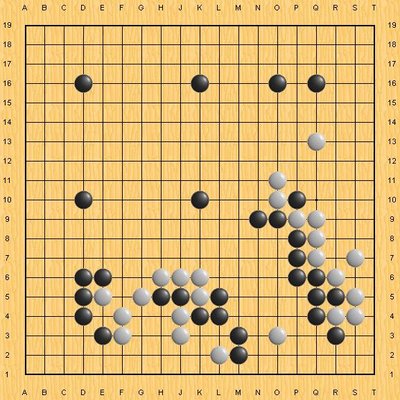
Black got a few points of overconcentrated territory and was not happy. Let's see again what went wrong.
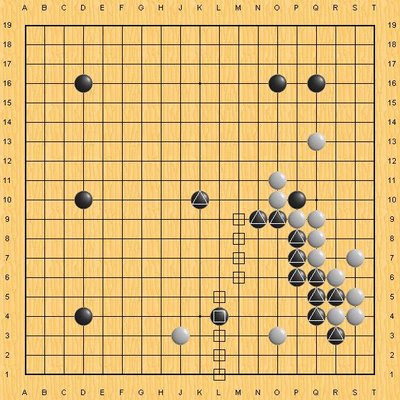
minue622 [7d?]: in this game,
minue622 [7d?]: main focus is B's left side,
minue622 [7d?]: not b's bottom right territory
minue622 [7d?]: this stone is strong?
minue622 [7d?]: i mean, these black wall is thick?
NannyOgg [-]: yes, it seems very obvious now
NannyOgg [-]: i was just thinking SPLIT him , and not thinking whole board
minue622 [7d?]: fundamental reason is that u have this wrong "fixed concept"
minue622 [7d?]: ==>
minue622 [7d?]: i spent alot of stones to make wall,
minue622 [7d?]: so, i have to defend this area as my territory always
minue622 [7d?]: correct way of thinking is --> I spent many stones to make influence. and i can use these wall Either to make my territory efficiently , but, depending on situation, I can use them in a different way, (to attack white ,driving it toward my wall)
Yes, all sounds perfectly reasonable, now I just have to make sure to use it correctly in my games. Taking this as today's main lesson to ponder.
This was the position:

W just played the marked stone. Pretty clearcut, B has lots of thickness and needs to use it. My kyu mind immediately came to the conclusion that I should use this thickness for fighting, and I'd better split the two W stones and get them into trouble. I sometimes get carried away by my natural aggression.

I totally and utterly missed the bigger picture of driving W towards my wall. The obvious direction of play. The only direction of play.

minue622 [7d?]: so here,
minue622 [7d?]: A is better, (to drive white toward wall)
minue622 [7d?]: also, A is (pincer + corner enclosure)
minue622 [7d?]: very efficient move
This is one of the possible continuations.

Black allows White to break the bottom area, so that she can build on the left.
The game continuation was a lot uglier:

Black got a few points of overconcentrated territory and was not happy. Let's see again what went wrong.

minue622 [7d?]: in this game,
minue622 [7d?]: main focus is B's left side,
minue622 [7d?]: not b's bottom right territory
minue622 [7d?]: this stone is strong?
minue622 [7d?]: i mean, these black wall is thick?
NannyOgg [-]: yes, it seems very obvious now
NannyOgg [-]: i was just thinking SPLIT him , and not thinking whole board
minue622 [7d?]: fundamental reason is that u have this wrong "fixed concept"
minue622 [7d?]: ==>
minue622 [7d?]: i spent alot of stones to make wall,
minue622 [7d?]: so, i have to defend this area as my territory always
minue622 [7d?]: correct way of thinking is --> I spent many stones to make influence. and i can use these wall Either to make my territory efficiently , but, depending on situation, I can use them in a different way, (to attack white ,driving it toward my wall)
Yes, all sounds perfectly reasonable, now I just have to make sure to use it correctly in my games. Taking this as today's main lesson to ponder.
Saturday, November 18, 2006
Even a Moron...
Remember the famous Kageyama quote 'Even a moron connects against a peep.'?
Last night, I was playing a game where I decided to go creative. Should just have played the simple connection. But nope, I wondered 'What happens if I play there instead?' I'll tell you what happened. I died. A totally miserable and unnecessary death. Painful. Good reminder to go back to basics.
Minue: 'Basics moves are "Basic" becuz they are usually best or better (most of time) than the other moves in Go. Basics doesn't mean something "low level" , but "Usually pro-ish move". Those moves are the first things to consider. We reject basic moves, when we have "Strong reasons" for it.'
In hindsight, naturally my reasons cannot be considered strong, even if they seemed like a good idea at the time. Yet another episode of 'Die and learn!'
Off to go club now, study session time! During our Thursday meetings we play, on our Saturday meetings we focus on studying.
Last night, I was playing a game where I decided to go creative. Should just have played the simple connection. But nope, I wondered 'What happens if I play there instead?' I'll tell you what happened. I died. A totally miserable and unnecessary death. Painful. Good reminder to go back to basics.
Minue: 'Basics moves are "Basic" becuz they are usually best or better (most of time) than the other moves in Go. Basics doesn't mean something "low level" , but "Usually pro-ish move". Those moves are the first things to consider. We reject basic moves, when we have "Strong reasons" for it.'
In hindsight, naturally my reasons cannot be considered strong, even if they seemed like a good idea at the time. Yet another episode of 'Die and learn!'
Off to go club now, study session time! During our Thursday meetings we play, on our Saturday meetings we focus on studying.
Tuesday, November 14, 2006
Back To Studying
OK, I spent enough time wallowing in self pity. Today, I actually went back to serious studying, or at least, as much as I could with constant kids interruptions. First studied a bunch of positions from Cho Chikun's Life and Death Dictionary to cover some l/d. The rest of the day, I spent reviewing pro games, mostly to get the bad effects of the mindless blitz out of my head. No idea whether it works that way, but I enjoyed going through them.
The best thing, I didn't play any mindless blitz. Will log on to KGS now and might play a game, but will try to actually think while playing. Unlike last night, when my focus was non-existing, even in my slow game. Heck, I might even do more go problems, now that I am back into studying.
Didn't use any painkillers again today, which sure does help. I just ignore the pain now, seems effective enough :)
The best thing, I didn't play any mindless blitz. Will log on to KGS now and might play a game, but will try to actually think while playing. Unlike last night, when my focus was non-existing, even in my slow game. Heck, I might even do more go problems, now that I am back into studying.
Didn't use any painkillers again today, which sure does help. I just ignore the pain now, seems effective enough :)
Stupid Leg
I am still majorly annoyed by the way the pain killers and visitors interfered with my go playing last week. Today, I didn't take any pain killers, but my go still sucked. Solved it by playing mindless blitz games, not a good habit.
Tomorrow, will have to study for real. A friend told me reassuringly: 'Soon all your friends will stop visiting and the pain will go down and then you can study tons of Go and get STRONG!!'
Looking forward to it!
Tomorrow, will have to study for real. A friend told me reassuringly: 'Soon all your friends will stop visiting and the pain will go down and then you can study tons of Go and get STRONG!!'
Looking forward to it!
Sunday, November 12, 2006
Kate's Very Own Goban
A go friend had this set, and gave it to Kate. It has the required 'tiny stones'.

She is thrilled.
This week, friends have been driving me to go club, since I haven't dared climbing into my monster van yet. Having only one usable leg is a pain. I also have discovered that go study isn't that effective if you use pain killers and get lots of visitors ^^. This weekend, I finally have been getting in some real games. I will have to sit with my leg elevated for weeks more, so I hope to get more go study in over the next weeks.

She is thrilled.
This week, friends have been driving me to go club, since I haven't dared climbing into my monster van yet. Having only one usable leg is a pain. I also have discovered that go study isn't that effective if you use pain killers and get lots of visitors ^^. This weekend, I finally have been getting in some real games. I will have to sit with my leg elevated for weeks more, so I hope to get more go study in over the next weeks.
Friday, November 10, 2006
Go...
I was looking for a goban with tiny stones for Kate, and came across this editorial quote about the game 'Go is probably one of the world's most intimidating games, one which conjures up images of players gleefully setting out for blood as they devise militaristic board moves.'
Interesting way of putting it :)
Interesting way of putting it :)
More Shodan Musings
Yesterday, I talked to a friend about similarities between go and martial arts. He had an interesting observation. I told him 'I am getting closer to the once coveted shodan. Although now that I am getting close, shodan seems pretty weak and no big deal anymore, i still have soooooooooooooooo much to learn!. He replied: 'WOW That's really awesome. And yes that's exactly how i feel about the shodan issue in budo too. In Japan no-one cares about shodan....all it means is that you're actually a student of whatever art you study rather than just someone checking it out. People only say things like "i have sandan" or "I have godan". If they're only shodan they say that they are "studying jujitsu" and if they're under shodan they don't talk about it. Pretty different from here where everyone just quits after shodan.'

Looking at the AGA ranking histogram, many people seem to quit after reaching shodan in go too. Is it because they reached the goal they set themselves? Do they lose interest and quit go? Or they stop studying, or maybe the stones are so far apart at that level that many people don't want to go through all the work to get stronger? The thread about 'Shodan... and then?' on godiscussions.com has been interesting to read. I like the way Chiyodad expressed himself: 'Shodan is nothing more than a beacon to guide the first leg of your journey. After you get there, you find a farther destination and carry on. You had better be enjoying the trip because I suspect that every destination will really turn out to be nothing more than a road-sign that says "You are here". '

Looking at the AGA ranking histogram, many people seem to quit after reaching shodan in go too. Is it because they reached the goal they set themselves? Do they lose interest and quit go? Or they stop studying, or maybe the stones are so far apart at that level that many people don't want to go through all the work to get stronger? The thread about 'Shodan... and then?' on godiscussions.com has been interesting to read. I like the way Chiyodad expressed himself: 'Shodan is nothing more than a beacon to guide the first leg of your journey. After you get there, you find a farther destination and carry on. You had better be enjoying the trip because I suspect that every destination will really turn out to be nothing more than a road-sign that says "You are here". '
Tuesday, November 07, 2006
Lots of Study Time
Good news and bad news. The good news is that I will have lots of time to sit around and study go. The bad news is that I broke my leg ^^
It's not a bad break, mostly a big annoyance. I have a splint and crutches now, and am supposed to sit around and rest a lot, keeping it elevated. Perfect opportunity to get more studying in then I usually can do.
Will have to spend some time making up good stories on how I broke my leg, since I am sure lots of people will ask. Would be nice to have some variety :) Last night on the server:
NannyOgg: I broke my leg!
friend: How did you manage to do that?
NannyOgg: Well, I was hiking through the woods, and met this bear...
NannyOgg: But you should see what he looked like after this!
friend: Really?
NannyOgg: No, but it does make for a pretty good story, doesn't it?
friend: Yes, it sure does.
It's not a bad break, mostly a big annoyance. I have a splint and crutches now, and am supposed to sit around and rest a lot, keeping it elevated. Perfect opportunity to get more studying in then I usually can do.
Will have to spend some time making up good stories on how I broke my leg, since I am sure lots of people will ask. Would be nice to have some variety :) Last night on the server:
NannyOgg: I broke my leg!
friend: How did you manage to do that?
NannyOgg: Well, I was hiking through the woods, and met this bear...
NannyOgg: But you should see what he looked like after this!
friend: Really?
NannyOgg: No, but it does make for a pretty good story, doesn't it?
friend: Yes, it sure does.
Monday, November 06, 2006
The $2.41 9x9 Go Set
Ash asked about the 9x9 board I am using for Kate, and I thought the answer would be useful enough to spend a post, instead of burying it in the comments.
A KGS friend made a 9x9 board for us. It is made out of plywood, has the lines drawn on it and has varnish applied to it. Simple, cheap and practical.

I am showing it here next to my normal goban, to give you an idea of the size.
I know iceman has done something similar for his go club at school. But if you don't want to go through all that, there is an even easier and cheaper solution.
When I was researching what to put in my Ancient Game of Go II Geocache, I was in contact with Anton Ninno of the Syracuse Go Club. He told me about the $2.41 go set he had developed. He sent me a pdf file of a 9x9 board, which you can print and use to play. For 'stones', you can use nickles and pennies. Forty nickles and forty-one pennies give you a cost of $2.41 for the whole set. Of course, can use anything else for stones too. For my cache, I went to Staples, and had the goban copied on cardstock, so it would be a bit more durable.
Yutopian has a somewhat nicer version of a 9x9 board. It is laminated, 9x9 on one side, 13x13 on the other. I haven't seen it, so don't know the quality, but I did see that the corresponding 13x13/19x19 one got good reviews.
Hope this helps.
A KGS friend made a 9x9 board for us. It is made out of plywood, has the lines drawn on it and has varnish applied to it. Simple, cheap and practical.

I am showing it here next to my normal goban, to give you an idea of the size.
I know iceman has done something similar for his go club at school. But if you don't want to go through all that, there is an even easier and cheaper solution.
When I was researching what to put in my Ancient Game of Go II Geocache, I was in contact with Anton Ninno of the Syracuse Go Club. He told me about the $2.41 go set he had developed. He sent me a pdf file of a 9x9 board, which you can print and use to play. For 'stones', you can use nickles and pennies. Forty nickles and forty-one pennies give you a cost of $2.41 for the whole set. Of course, can use anything else for stones too. For my cache, I went to Staples, and had the goban copied on cardstock, so it would be a bit more durable.
Yutopian has a somewhat nicer version of a 9x9 board. It is laminated, 9x9 on one side, 13x13 on the other. I haven't seen it, so don't know the quality, but I did see that the corresponding 13x13/19x19 one got good reviews.
Hope this helps.
Sunday, November 05, 2006
9x9 as Teaching Tool
We have been playing 9x9 high handicap games with Kate. Today we added the challenge: Try to kill every single W stone. This is after a discussion with minue. He said: 'L&D is the conceptual basis of Go, and concept of territory is just a derived one from it. So mastering L&D of stones is first thing to do. I want to let her practice basic Atari and killing problems in 9H game. Go is a game about "how to ensure survival of my present and future stones and prevent survival of opponent's present and future stones." If we do that job well, more territory is gained just automatically as a side effect. Sacrificing to gain more territory, giving up my weak stones is a sort of trade between death of my present stones and survival of my futher stones'
Interesting, makes a lot of sense. I never had thought about using 9H on a 9x9 board that way. It is fun to set up ways for her to kill stones :) She even often figures out the vital point of a group. And one game, she saw a W group had miai for life and she decided 'If I play here, he can play there and he will live. But if I play there, he will play here and live. So he will live anyway. OK, I will resign.' ^^ And she did. And went off to play a computer game :) Nice to see how she didn't get upset about losing, she was very matter-of-fact about it. I have been telling her how she is supposed to lose half of her games, and looks like she understands and accepts that.

Here she is setting up go problems for her 5 years-old brother, who is utterly uninterested in go. Fun to see how she made up her own problems, and made sure to keep them simple for him. He never wanted to do them, but she got her father to solve them instead ^^.
I hope sharing the way we teach Kate, will help other people who are teaching beginners. And I have to say that I am utterly fascinated by the way she is picking up the game and is figuring out things. It is cool to watch her alternate making amazingly good moves, and nonsense ones.
Interesting, makes a lot of sense. I never had thought about using 9H on a 9x9 board that way. It is fun to set up ways for her to kill stones :) She even often figures out the vital point of a group. And one game, she saw a W group had miai for life and she decided 'If I play here, he can play there and he will live. But if I play there, he will play here and live. So he will live anyway. OK, I will resign.' ^^ And she did. And went off to play a computer game :) Nice to see how she didn't get upset about losing, she was very matter-of-fact about it. I have been telling her how she is supposed to lose half of her games, and looks like she understands and accepts that.

Here she is setting up go problems for her 5 years-old brother, who is utterly uninterested in go. Fun to see how she made up her own problems, and made sure to keep them simple for him. He never wanted to do them, but she got her father to solve them instead ^^.
I hope sharing the way we teach Kate, will help other people who are teaching beginners. And I have to say that I am utterly fascinated by the way she is picking up the game and is figuring out things. It is cool to watch her alternate making amazingly good moves, and nonsense ones.
Friday, November 03, 2006
Teaching Kate
Finally! The day arrived that one of my kids actually is interested in go. Kate is still very enthousiastic about playing, let's hope that it will last.
Interesting concepts are popping up while teaching her. She knows about ladders, but I never had shown her geta (net) yet.

I put this on the board for her, and asked her to capture the W stone. She immediately made a ladder and captured it that way.
Next question I posed to her, 'What if I play a ladder breaker?' We first checked whether and how the ladder breaker broke the ladder.

Then I asked her whether she could find a move to capture the W stone, even if there was a ladder breaker. She came up with those two.

and

Not bad, Kate, not bad. And fascinating to see what she came up with. Both her moves worked great. I showed her the basic netting move in addition to those, and she immediately grasped why it worked. So cool!
She has her own KGS id now and is enjoying playing me and some friends on line. When she plays me a lot of her kibbitz consists of 'DIE DIE DIE DIE!'. She sure has the trash talking down, I wonder where she got that ^^
She was playing a friend on line and it was funny to hear her talk while playing. Some quotes:
She started against him in a 9H game on a 9x9 board. She was very impressed. 'WOW! I didn't know you could do something like that! I got EVERY single bit, grass, silver, gold!!!' (I have told her that the Chinese have proverb saying corner is gold, side is silver, center is grass.
Can you tell I am excited about her playing go? I realize it might not last more than a few weeks, but I am enjoying it as long as it will last. She told me 'I learned a lot about go by playing capture go. I never wanted to play real go, because I thought it was boring. But now I see how much fun it is to grab lots of territory!!!'
Interesting concepts are popping up while teaching her. She knows about ladders, but I never had shown her geta (net) yet.

I put this on the board for her, and asked her to capture the W stone. She immediately made a ladder and captured it that way.
Next question I posed to her, 'What if I play a ladder breaker?' We first checked whether and how the ladder breaker broke the ladder.

Then I asked her whether she could find a move to capture the W stone, even if there was a ladder breaker. She came up with those two.

and

Not bad, Kate, not bad. And fascinating to see what she came up with. Both her moves worked great. I showed her the basic netting move in addition to those, and she immediately grasped why it worked. So cool!
She has her own KGS id now and is enjoying playing me and some friends on line. When she plays me a lot of her kibbitz consists of 'DIE DIE DIE DIE!'. She sure has the trash talking down, I wonder where she got that ^^
She was playing a friend on line and it was funny to hear her talk while playing. Some quotes:
- I must take my territory!
- Uh oh! He has more territory, and I can't solve that! Wait! With my handicap I can! Here i can make one eye and here another one! He made me TWO eyes!!!!!!!! (after generous non-killing play by W :)
- Uhoh, mommy! He is invading again! Oh no you won't! I shall kill you before you even live!
- Oops , I played a bad move, oh well!
- See! I just sacrificed a stone!'
- Wait , I'll do the same trick, sacrifice! (while trying to kill)
She started against him in a 9H game on a 9x9 board. She was very impressed. 'WOW! I didn't know you could do something like that! I got EVERY single bit, grass, silver, gold!!!' (I have told her that the Chinese have proverb saying corner is gold, side is silver, center is grass.
Can you tell I am excited about her playing go? I realize it might not last more than a few weeks, but I am enjoying it as long as it will last. She told me 'I learned a lot about go by playing capture go. I never wanted to play real go, because I thought it was boring. But now I see how much fun it is to grab lots of territory!!!'
Thursday, November 02, 2006
About Winning
 Shygost had an interesting viewpoint in one of his reviews. He was talking about attacking a group and said: 'Not only do you not have to kill, you don't have to win! In chess , you have to win, but not so in go. If you win more than half of your games, they increase or decrease the handicap, and you are back to losing. You are not supposed to win your games. You are supposed to just enjoy, get some good thinking in there.'
Shygost had an interesting viewpoint in one of his reviews. He was talking about attacking a group and said: 'Not only do you not have to kill, you don't have to win! In chess , you have to win, but not so in go. If you win more than half of your games, they increase or decrease the handicap, and you are back to losing. You are not supposed to win your games. You are supposed to just enjoy, get some good thinking in there.'Interesting, makes a lot of sense. Not that I thought go was all about winning anyway, but I never had looked at it in exactly this way.
My 7 years-old daughter has started to play more go, she desperately wants her own goban with tiny stones. She plays 9x9 games at club now,and is mostly out of the self-atari phase ^^ I hope she will stick to it. Two more weeks of club play and she will get her very own goban.
Friday, October 27, 2006
Memorizing Pro Games
I always enjoy studying and memorizing pro games (usually the first 100 moves, I don't do yose) and I am adding a new layer to this study. Over time, I have memorized a bunch of pro games. My issue is that after a while, I forget them, or at least, can't perfectly recall them in my mind. The big lines will still be there, but I get lost in the itty bitty gritty details.
My new project is finding a way to get more of them into my long term memory, trying to figure out the best way to do so. I started about five days ago, and have added one game a day to the ones I want to get into 'can recall perfectly at any given moment' pool. I replay all the games which I know already and add one new (well, formerly memorized) game to the repository.
No idea whether this is the best way, I would welcome any tips or insights people might have about this.
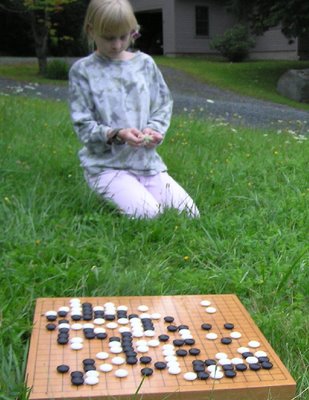
Bonus points to anyone who correctly identifies the game I am adding today.
My new project is finding a way to get more of them into my long term memory, trying to figure out the best way to do so. I started about five days ago, and have added one game a day to the ones I want to get into 'can recall perfectly at any given moment' pool. I replay all the games which I know already and add one new (well, formerly memorized) game to the repository.
No idea whether this is the best way, I would welcome any tips or insights people might have about this.

Bonus points to anyone who correctly identifies the game I am adding today.
Wednesday, October 25, 2006
Blitz Go Revisited
Well, it was fun to play a lot of blitz for a while, but Minue said that at my level doing lots of easy problems was more useful for improving. Which makes sense, my blitz go does suck , and do I really want to ingrain those sucky moves into my head? I will still play an occasional blitz game for fun, but I am NOT going for quantity anymore. Going for sanity and quality instead.

This said, I entered the Advanced Study Room Ranking Tournament in which I do play slow and serious games. And found out that I still do not do well with tourney stress. This is definitely something I need to work on. My focus just totally SUCKED in the beginning of my last tourney game. I plunked stones and made tons of mistakes, blech. Not only that, but I checked out the chat in every KGS room, read email, and chattered away to a good friend. Who told me to stop chatting and start focusing. NOW! (I love you, flame ^^)
I was pretty far behind by then, after having made about every bad move imaginable. I minimized all my windows, focused and started playing good moves. At least, a lot better than the first half of the game. I won the game, but I was not impressed with my quality of play in the first half. As in, it sucked.

It seems so easy. Play and focus. Just don't get distracted. But my mind races in 5,000 different directions. And my mouse clicks on all those other windows. This is all about focus and discipline.
My friend told me that counting helps him, and recommended that I would start counting more often. It helps him to focus and to know what should happen. I do count, but not often enough yet. Will try that out. I also have resolved myself to just closing every single room when I am playing. I have done that before and it helped a lot, but I have been slacking. Bad habit.
I see a lot of similarity with my aikido, it is all about focus and presence. During the workshop, I found it really helpful to breathe slowly and sit on my hands, just focusing on the game, focusing on the board, evaluating the position, not playing hasty moves. At least, not as many as usual ^^.
This is easier to do in real life games, but I know I should be able to do this in internet games too, and beat my own bad habits. I only have to hold up a mirror to see my worst enemy on the go board. I will overcome this.

This said, I entered the Advanced Study Room Ranking Tournament in which I do play slow and serious games. And found out that I still do not do well with tourney stress. This is definitely something I need to work on. My focus just totally SUCKED in the beginning of my last tourney game. I plunked stones and made tons of mistakes, blech. Not only that, but I checked out the chat in every KGS room, read email, and chattered away to a good friend. Who told me to stop chatting and start focusing. NOW! (I love you, flame ^^)
I was pretty far behind by then, after having made about every bad move imaginable. I minimized all my windows, focused and started playing good moves. At least, a lot better than the first half of the game. I won the game, but I was not impressed with my quality of play in the first half. As in, it sucked.

It seems so easy. Play and focus. Just don't get distracted. But my mind races in 5,000 different directions. And my mouse clicks on all those other windows. This is all about focus and discipline.
My friend told me that counting helps him, and recommended that I would start counting more often. It helps him to focus and to know what should happen. I do count, but not often enough yet. Will try that out. I also have resolved myself to just closing every single room when I am playing. I have done that before and it helped a lot, but I have been slacking. Bad habit.
I see a lot of similarity with my aikido, it is all about focus and presence. During the workshop, I found it really helpful to breathe slowly and sit on my hands, just focusing on the game, focusing on the board, evaluating the position, not playing hasty moves. At least, not as many as usual ^^.
This is easier to do in real life games, but I know I should be able to do this in internet games too, and beat my own bad habits. I only have to hold up a mirror to see my worst enemy on the go board. I will overcome this.
Friday, October 20, 2006
Blitz Go
After thinking about someone's advice for a while ("Play many fast games"), I decided to go ahead and create myself a blitz account. I know I totally suck at blitz, and did not want to taint my NannyOgg account with those games. I mean, we all know that making a bad move signifies we must be horrible persons. Heck, even worse making a bad move when people are watching, they will just loathe me for being so detestable. Go still seems to be way more tied into my self-esteem than I'd like to admit.
During my usual games, the conditions have to be just right. I set up everything so that I can have a long and leisurely game, thinking about every move, wearing the right socks, drinking the proper tea. Yes, a game can be quite a commitment. I have a few screw-up accounts around, but I almost never play them.
Blitz games were an interesting thought, but I decided that this definitely had to be a private account.
I made this new account, put up a game and started playing. I created it six days ago, and have played thirty games so far. Not bad for someone who usually plays one or two games a day. Yes, I suicided quite a few times, and I discovered that I really should get better at killing in a hurry. But I have tremendously enjoyed the variety of opponents I have been playing. I play 25 stones in 3 minutes. Blitzish, but not too badly so. Still, a lot faster than my normal game.
I play whoever challenges me first. I play anyone, question marks, guests, escapers, and worms. This is an account to get experience after all, I want a lot of games in. My guests have ranged from the 30k who just started playing to the dan player intent on killing every single stone on the board.
I have met only one escaper so far, and that was when the server was having problems anyway, so I'd like to think he got disconnected.
Most notable games:
- Playing as W against a B tengen opening and then losing my cutting stones in the following fight. I managed to come back when I killed one of his groups due to time pressure. Glad I am not the only one who messes up when pressured.
- Leaving too much thinness and bad shape against a weaker opponent, and getting punished for it. Yes, that was bad. I knew he wouldn't see it and then he did. Teaches me a lot about my own go and my own attitude.
- Someone getting upset about this being a blitz game.
Me: Thank you
Him: so fast??
Me: blitz
Him: dont say thank to me
Him: i think no fair
Him: if u have not time u can add
Me: it's blitz, it blinks when you join
Me: to show it's a fast game
Him: so u think u can finish it on time?
Me: no, i want to practice making good shape without reading much
Him: u play not good
Him: but u cheat
I usually do a quick review of my game and see where I lost the game or where I could have done better. Not a full blown review, since I don't think that makes much sense for a blitz game. But a 'when did I get myself into this mess????' kind of thing.
I have games to post, but blogger has been a pain all day, so will have to wait to see more serious games. Yesterday, I played a good game at club, experimented with a new followup on mini chinese. I have been looking at that game a lot and figuring out quite a lot of moves to improve upon.
During my usual games, the conditions have to be just right. I set up everything so that I can have a long and leisurely game, thinking about every move, wearing the right socks, drinking the proper tea. Yes, a game can be quite a commitment. I have a few screw-up accounts around, but I almost never play them.
Blitz games were an interesting thought, but I decided that this definitely had to be a private account.
I made this new account, put up a game and started playing. I created it six days ago, and have played thirty games so far. Not bad for someone who usually plays one or two games a day. Yes, I suicided quite a few times, and I discovered that I really should get better at killing in a hurry. But I have tremendously enjoyed the variety of opponents I have been playing. I play 25 stones in 3 minutes. Blitzish, but not too badly so. Still, a lot faster than my normal game.
I play whoever challenges me first. I play anyone, question marks, guests, escapers, and worms. This is an account to get experience after all, I want a lot of games in. My guests have ranged from the 30k who just started playing to the dan player intent on killing every single stone on the board.
I have met only one escaper so far, and that was when the server was having problems anyway, so I'd like to think he got disconnected.
Most notable games:
- Playing as W against a B tengen opening and then losing my cutting stones in the following fight. I managed to come back when I killed one of his groups due to time pressure. Glad I am not the only one who messes up when pressured.
- Leaving too much thinness and bad shape against a weaker opponent, and getting punished for it. Yes, that was bad. I knew he wouldn't see it and then he did. Teaches me a lot about my own go and my own attitude.
- Someone getting upset about this being a blitz game.
Me: Thank you
Him: so fast??
Me: blitz
Him: dont say thank to me
Him: i think no fair
Him: if u have not time u can add
Me: it's blitz, it blinks when you join
Me: to show it's a fast game
Him: so u think u can finish it on time?
Me: no, i want to practice making good shape without reading much
Him: u play not good
Him: but u cheat
I usually do a quick review of my game and see where I lost the game or where I could have done better. Not a full blown review, since I don't think that makes much sense for a blitz game. But a 'when did I get myself into this mess????' kind of thing.
I have games to post, but blogger has been a pain all day, so will have to wait to see more serious games. Yesterday, I played a good game at club, experimented with a new followup on mini chinese. I have been looking at that game a lot and figuring out quite a lot of moves to improve upon.
Sunday, October 15, 2006
Temporary Insanity
This was my Saturday morning game. It includes one moment of temporary insanity. One of those moments when you see the right move, know it is the right move, are totally convinced it is the perfect move. But somehow one second before you put down your stone, you change your mind and put it somewhere else. Not only that, but you instantly HATE the move you put down. Detest it, loathe it. Kick yourself over it and vow never to play go again. (OK, maybe not that last one, but I was very annoyed with myself)
This was the position:

A clearly is the best move here, so of course, I played B. I put it down and stared at it in horror. After that move, I spent a lot of time literally sitting on my hands, making sure I would not do something like that again ^^
Another notable moment in the game. I played the one space high pincer when he approached my hoshi corner, planning to play those moves.

The game went differently but we saw it in review, and she said this was not a good exchange for B. I always thought it would be good to get 3 in sente if W would fix the ko right now. Or have the ko hanging over W's head if he didn't fix. We didn't really go into it, I will have to figure out when Black 1 would be a good move and when it isn't.
This weekend, I learned how to put in variations and comments in my PDA, which was very helpful. After each review, I would spend some time going over the game in my PDA and add her comments. When I came home, I took the files and cleaned them up, expanding on the one or two-word comments. Very useful skill to learn.
Now I need to learn how to convince my PDA not to trash my files during sync-ing, sigh.
This was the position:

A clearly is the best move here, so of course, I played B. I put it down and stared at it in horror. After that move, I spent a lot of time literally sitting on my hands, making sure I would not do something like that again ^^
Another notable moment in the game. I played the one space high pincer when he approached my hoshi corner, planning to play those moves.

The game went differently but we saw it in review, and she said this was not a good exchange for B. I always thought it would be good to get 3 in sente if W would fix the ko right now. Or have the ko hanging over W's head if he didn't fix. We didn't really go into it, I will have to figure out when Black 1 would be a good move and when it isn't.
This weekend, I learned how to put in variations and comments in my PDA, which was very helpful. After each review, I would spend some time going over the game in my PDA and add her comments. When I came home, I took the files and cleaned them up, expanding on the one or two-word comments. Very useful skill to learn.
Now I need to learn how to convince my PDA not to trash my files during sync-ing, sigh.
Two space low pincer after high approach to komoku
Last night, I played a quick game and met this pincer:
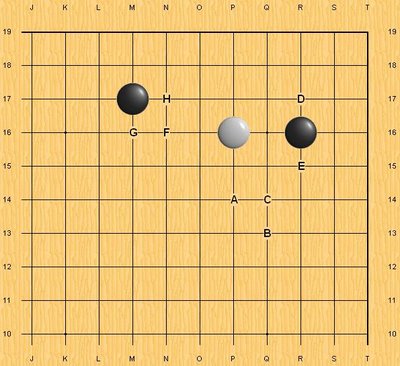
I don't see that one very often. After the game, I looked up the pincer to see what's up with it. Kogo's claimed "This is a rare move, undecided between the two intentions of putting pressure on White, or influencing the top left side." It went on to tell "White conitnues with A, B, C or D. White needs the ladder for B. The moves E, F, G and H are mistakes." Ah, that explains why playing E got me into trouble.
B is interesting. The ladder it needs shows up here:
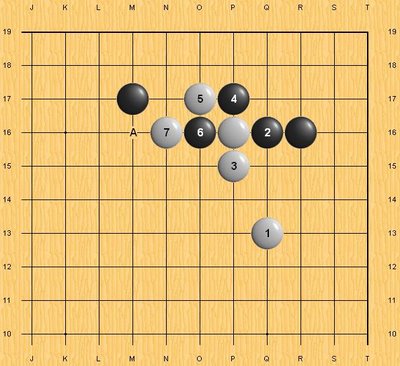
Now the pincer stone is placed awkwardly. If it was placed at A, it would be a ladder breaker, but it's placed too low and Black ends up with a low position.

If B chooses this variation:

In contrast to the pincer stone being on A, White doesn't need the ladder for the triangled move, so pincer is badly positioned.
Interesting. Now I will hopefully do better next time I meet this pincer.

I don't see that one very often. After the game, I looked up the pincer to see what's up with it. Kogo's claimed "This is a rare move, undecided between the two intentions of putting pressure on White, or influencing the top left side." It went on to tell "White conitnues with A, B, C or D. White needs the ladder for B. The moves E, F, G and H are mistakes." Ah, that explains why playing E got me into trouble.
B is interesting. The ladder it needs shows up here:

Now the pincer stone is placed awkwardly. If it was placed at A, it would be a ladder breaker, but it's placed too low and Black ends up with a low position.

If B chooses this variation:

In contrast to the pincer stone being on A, White doesn't need the ladder for the triangled move, so pincer is badly positioned.
Interesting. Now I will hopefully do better next time I meet this pincer.
Saturday, October 14, 2006
Hmmmm...
Today was listening to a KGS plus Guo Juan lecture. She said, to get strong, it is good to play many fast games and get killed many times. Just make strong shapes even if slow. You don't even need to attack, opponent will often just collapse on himself.
During the workshop, she told when she was training to become a pro, she often would play one hundred games a day, just very fast games. 5 minutes, 10 minutes, and lots of them.
Interesting. I usually stay away from fast games because of the interruptions in my household. Wondering whether I should re-think that.
During the workshop, she told when she was training to become a pro, she often would play one hundred games a day, just very fast games. 5 minutes, 10 minutes, and lots of them.
Interesting. I usually stay away from fast games because of the interruptions in my household. Wondering whether I should re-think that.
Friday, October 13, 2006
Midnight Madness
Everyone sane had long gone off to bed, but two of us decided to stay up and play a game. My big regret in this game was not invading his left side moyo when I could have. It was so obvious and easy when she reviewed it later. Still kicking myself over it.
This was the position.
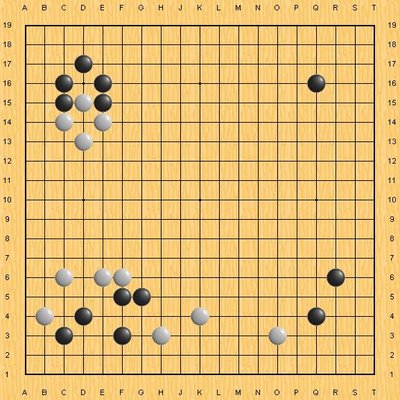
As you see, W is quite open on the left and the correct way to play would be this.

Instead, I decided to make the invasion much harder on myself, and I played Black 1.

Now W has some ideal moves to convert the left from moyo into territory. Bad idea for Black. It is pretty easy to see that now it is way harder to invade the left.
Friday night lesson. "Do not help your opponent."
This was the position.

As you see, W is quite open on the left and the correct way to play would be this.

Instead, I decided to make the invasion much harder on myself, and I played Black 1.

Now W has some ideal moves to convert the left from moyo into territory. Bad idea for Black. It is pretty easy to see that now it is way harder to invade the left.
Friday night lesson. "Do not help your opponent."
Tuesday, October 10, 2006
Back Home!
Back home from the workshop, I had a wonderful time. We arrived Friday night, and studied a pro game for a while. After dinner, she gave a lecture on that particular pro game, very interesting. When everyone went off to bed, I found myself an opponent and we played a game of midnight go. I got 3H and experimented with a new way of playing 3H games, I am still not sure whether I like it.
Saturday was playing, playing, playing and reviewing, reviewing, reviewing. I won one game and lost another one, mostly because I decided to suicide a 50 pts group in the center ("Oh, this group should be ok... Oh, it isn't...") Still lost by only 9pts, so not too bad considering the big blunder.
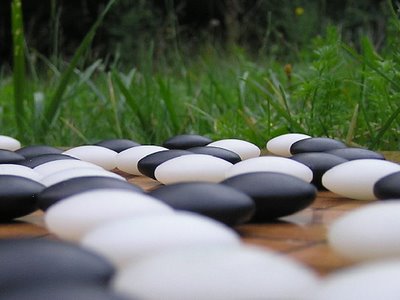
Sunday was more playing and reviewing. Again, lost one game and won one, so I am 2-2 for the weekend on my 'official' games. Played a bunch more 'just for fun' games.
Sunday night we played the traditional Survivor Go. The group gets divided into two teams and we play like rengo, taking turns making moves. When someone makes a bad move, he gets kicked out. This time one of the players managed to get himself kicked out twice... I got kicked out after a bunch of moves, I will post the game later.
Of course, I played even more go before going to bed, and then fell asleep while doing tsumego.
Monday morning, simul against all of us, 12 boards, and she won all of her games. I took 6H and did pretty well, it was a close game. In the end, she won by 4 points on the board. Not bad, considering she gave me 9H last time and I had lost very convincingly by late middle game back then.
My PDA acted up just now while downloading the game records, so they got lost for eternity, which I am not happy about. I am trying to recreate the game record from memory, but it turns out my memory isn't that good. Here is what I got. At least it gives some idea of the game, but I am very, very annoyed with my PDA just now.
Food for thought from this weekend (I made a list on my PDA and lost them, blech)
Now back to real life and to studying the games I played.
Saturday was playing, playing, playing and reviewing, reviewing, reviewing. I won one game and lost another one, mostly because I decided to suicide a 50 pts group in the center ("Oh, this group should be ok... Oh, it isn't...") Still lost by only 9pts, so not too bad considering the big blunder.

Sunday was more playing and reviewing. Again, lost one game and won one, so I am 2-2 for the weekend on my 'official' games. Played a bunch more 'just for fun' games.
Sunday night we played the traditional Survivor Go. The group gets divided into two teams and we play like rengo, taking turns making moves. When someone makes a bad move, he gets kicked out. This time one of the players managed to get himself kicked out twice... I got kicked out after a bunch of moves, I will post the game later.
Of course, I played even more go before going to bed, and then fell asleep while doing tsumego.
Monday morning, simul against all of us, 12 boards, and she won all of her games. I took 6H and did pretty well, it was a close game. In the end, she won by 4 points on the board. Not bad, considering she gave me 9H last time and I had lost very convincingly by late middle game back then.
My PDA acted up just now while downloading the game records, so they got lost for eternity, which I am not happy about. I am trying to recreate the game record from memory, but it turns out my memory isn't that good. Here is what I got. At least it gives some idea of the game, but I am very, very annoyed with my PDA just now.
Food for thought from this weekend (I made a list on my PDA and lost them, blech)
- When playing rengo, stronger player should follow the weaker player's lead, not the other way around. Interesting concept.
- One Chinese go teacher advises his students to just lose all their kos, giving a better overall result than fighting it and losing points that way. I have to think about that one.
- She stressed very much to play the open areas in fuseki, not make small local moves. And she had quite some opportunity this weekend to point out when yet another player didn't follow that advice.
Now back to real life and to studying the games I played.
Wednesday, October 04, 2006
Two Space High Approach to Komoku
Last night, I played a game against nugatory, where he approached my komoku three times with the two space high approach. He also played tengen as his first move (he was W) so it was a somewhat unconventional game.
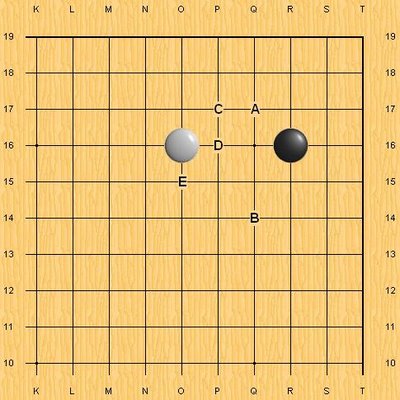
The very first time someone played this approach against me, I wasn't sure what to play, and kind of automatically answered Black A, since that's what I often play with the low 2 space approach. Made sense that it should be the same, right? Wrong! I looked it up later, and found out that A is considered submissive. So much for that. Ishida shows B to E as corner replies for Black.
Ishida also goes into the history of the move "O16 is a light move. White is not concerned about corner influence but is satisfied if he can get Black to answer here, as this means preventing B from making a corner enclosure, while keeping sente. From B's point of view, there is nothing wrong with replying as W wants, while he can also try to make W answer him. This approach move was very popular in the 1910's and almost all variations have been completely explored."
In my game, I chose C, which is "a territory-oriented move which forestalls the W attachment in the corner. W finds it a little submissive to respond to this move, so nowadays B most often plays like this."
W did respond and we ended up with the standard joseki:

Today, I spent some time with Ishida on this approach, and saw I could have gone for the large avalanche, but wouldn't have been good in my game. I just hadn't even realized I had that option.
Interesting.

The very first time someone played this approach against me, I wasn't sure what to play, and kind of automatically answered Black A, since that's what I often play with the low 2 space approach. Made sense that it should be the same, right? Wrong! I looked it up later, and found out that A is considered submissive. So much for that. Ishida shows B to E as corner replies for Black.
Ishida also goes into the history of the move "O16 is a light move. White is not concerned about corner influence but is satisfied if he can get Black to answer here, as this means preventing B from making a corner enclosure, while keeping sente. From B's point of view, there is nothing wrong with replying as W wants, while he can also try to make W answer him. This approach move was very popular in the 1910's and almost all variations have been completely explored."
In my game, I chose C, which is "a territory-oriented move which forestalls the W attachment in the corner. W finds it a little submissive to respond to this move, so nowadays B most often plays like this."
W did respond and we ended up with the standard joseki:

Today, I spent some time with Ishida on this approach, and saw I could have gone for the large avalanche, but wouldn't have been good in my game. I just hadn't even realized I had that option.
Interesting.
Tuesday, October 03, 2006
Atari Abuse
Over my last few games, I have had too many cases of atari abuse, so reiterating what I should know already, but obviously still screw up.
Best recent example was in a recent minue lesson. This position evolves from the R4 invasion into the Black moyo.

Black overplayed here and W wants to punish. One of my attempts at punishment was this:

I was feeling all smug and satisfied with myself, until minue pointed out to me that the White 3, Black 4 move trade is a big damage to W. Feh! I keep falling into the atari trap. And of course, it made total sense when he explained it.

minue622 [7d]: here, white has 2 options to play atari.
minue622 [7d]: each of them can help white , depending on B's later plays.
minue622 [7d]: if u decide ur atari too early, it means that u lost ur choice
minue622 [7d]: since u has fewer choice to exploit B's weakness,
minue622 [7d]: opponent can fight more easily
minue622 [7d]: so, we save our atari until we know which atari is really helpful for our contact fight
This would be normal followup if we skip the harmful atari
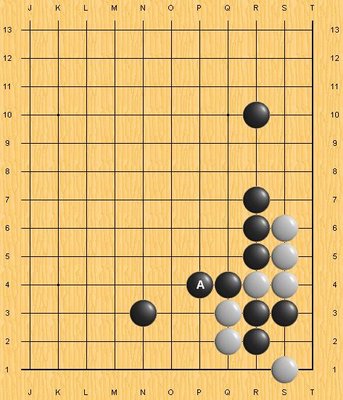
minue622 [7d]: now..
minue622 [7d]: black A is fine
minue622 [7d]: this is good for w
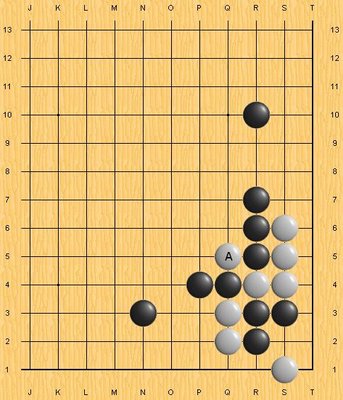
Here W would never ever play move A, so would have been bad if he had played this earlier in the sequence.
minue622 [7d]: Q5 is a nonsense
minue622 [7d]: in contact fight, save playing atari.
If we had saved playing atari, and Black plays this way...

We now have perfect followup play and know which atari is useful to us.

minue622 [7d]: black will capture Q3, and W breaks side
This all is so reasonable and logical, but I still too often mess it up in my play. And of course, I mess it up the other way too. When I rightfully should atari, I avoid it because I don't want to play a crude move. Some day, I'll figure it all out, right?
Best recent example was in a recent minue lesson. This position evolves from the R4 invasion into the Black moyo.

Black overplayed here and W wants to punish. One of my attempts at punishment was this:

I was feeling all smug and satisfied with myself, until minue pointed out to me that the White 3, Black 4 move trade is a big damage to W. Feh! I keep falling into the atari trap. And of course, it made total sense when he explained it.

minue622 [7d]: here, white has 2 options to play atari.
minue622 [7d]: each of them can help white , depending on B's later plays.
minue622 [7d]: if u decide ur atari too early, it means that u lost ur choice
minue622 [7d]: since u has fewer choice to exploit B's weakness,
minue622 [7d]: opponent can fight more easily
minue622 [7d]: so, we save our atari until we know which atari is really helpful for our contact fight
This would be normal followup if we skip the harmful atari

minue622 [7d]: now..
minue622 [7d]: black A is fine
minue622 [7d]: this is good for w

Here W would never ever play move A, so would have been bad if he had played this earlier in the sequence.
minue622 [7d]: Q5 is a nonsense
minue622 [7d]: in contact fight, save playing atari.
If we had saved playing atari, and Black plays this way...

We now have perfect followup play and know which atari is useful to us.

minue622 [7d]: black will capture Q3, and W breaks side
This all is so reasonable and logical, but I still too often mess it up in my play. And of course, I mess it up the other way too. When I rightfully should atari, I avoid it because I don't want to play a crude move. Some day, I'll figure it all out, right?
Subscribe to:
Posts (Atom)
